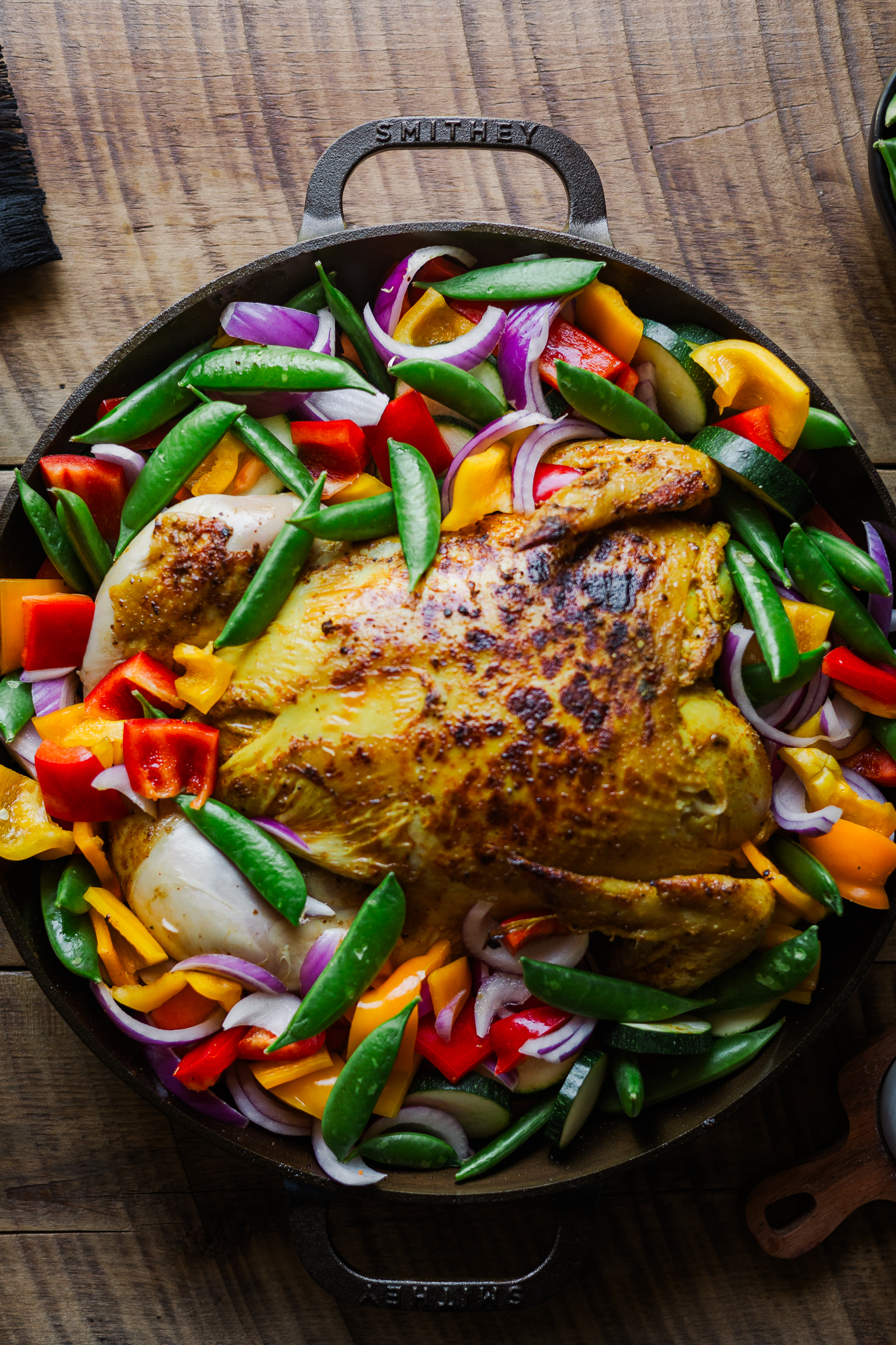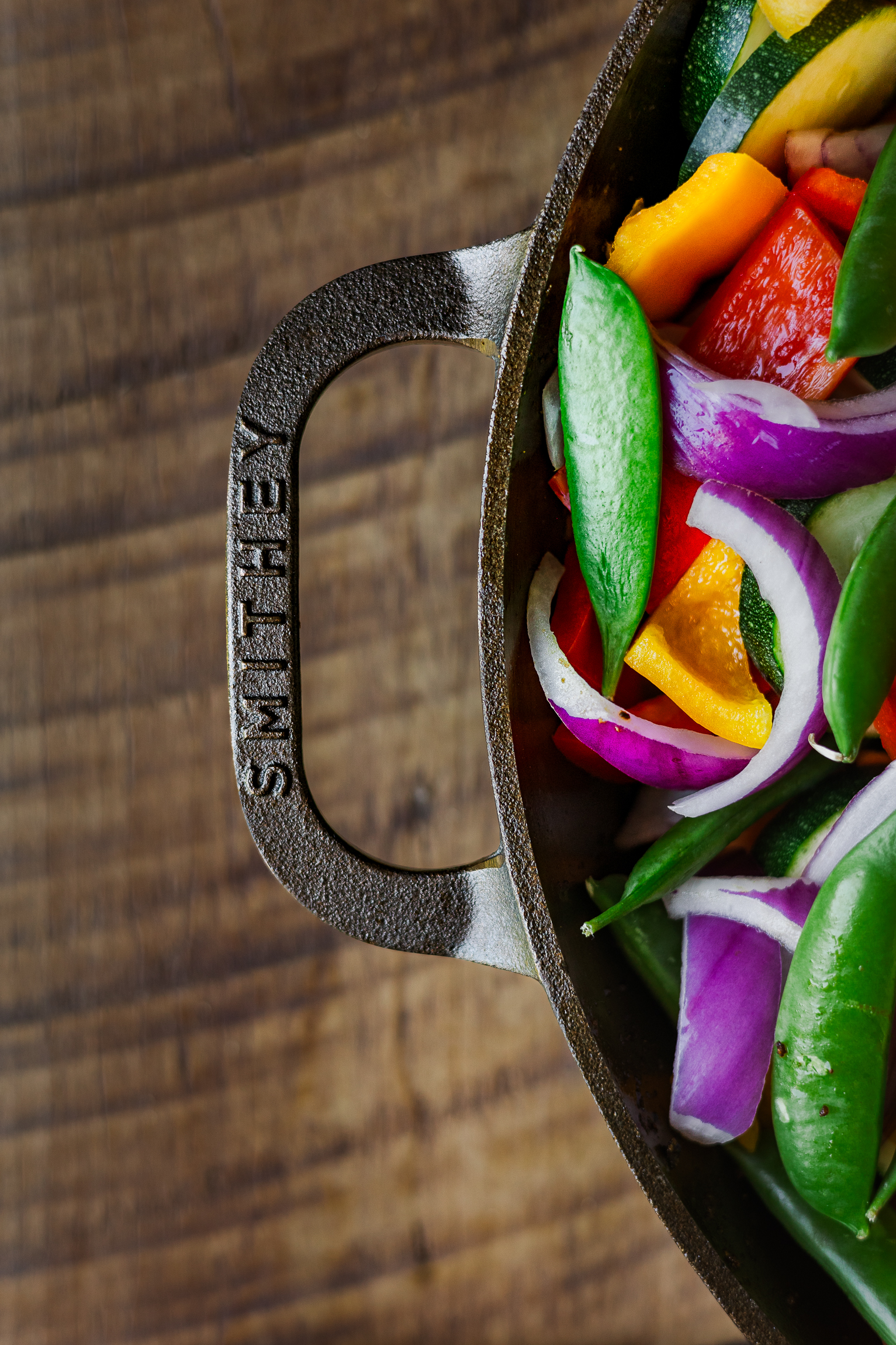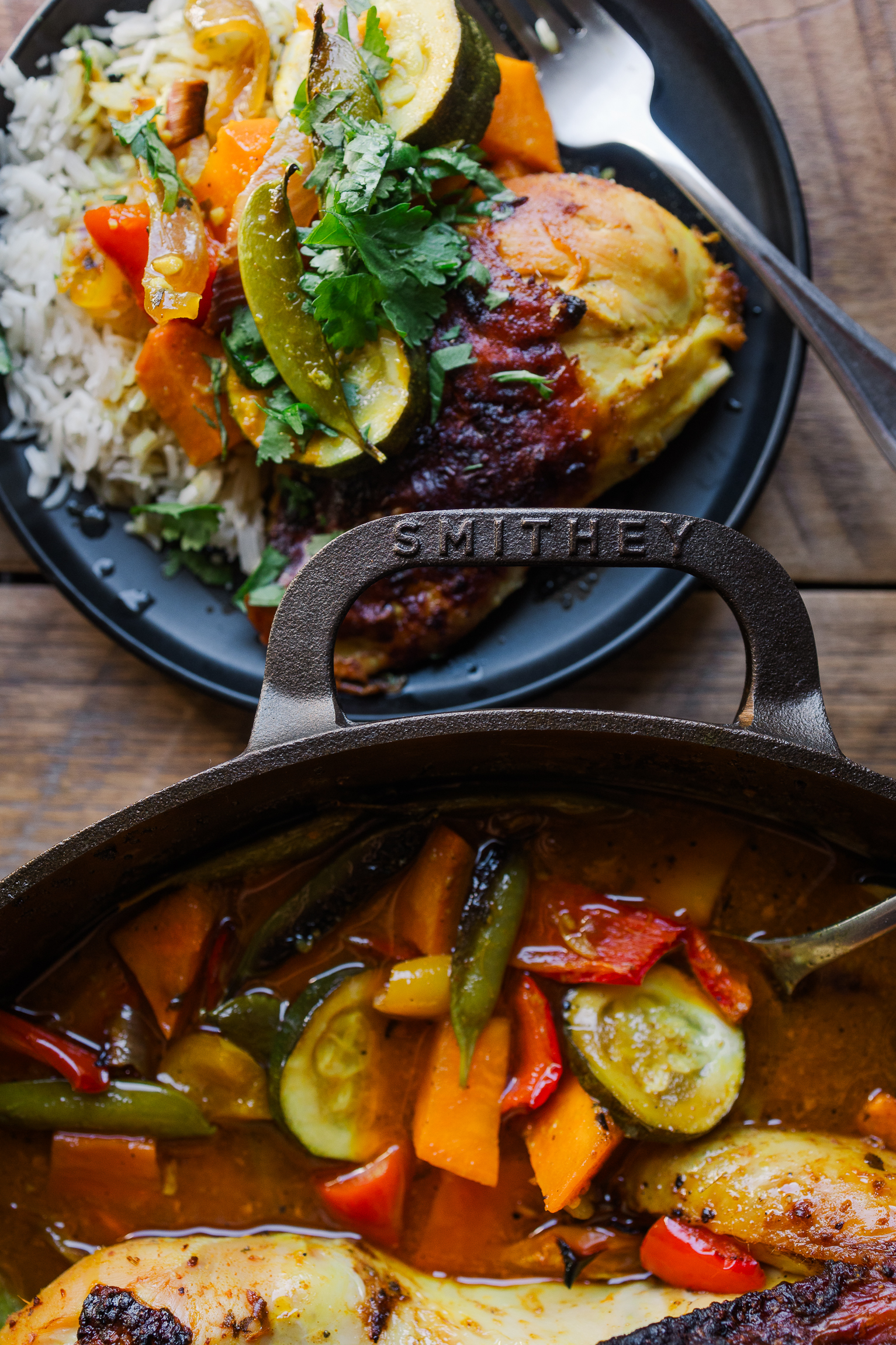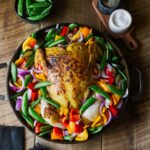Sometimes, you create a recipe that is so delicious that you surprise yourself!
This Thai Spatchcock Chicken recipe might be the best chicken I’ve ever had. It might also have something to do with the absolutely stunning Smithey Ironware No. 14 Skillet I cooked it in!
My husband and I are huge fans of cast iron skillets! Our current collection is ten, ranging from cornbread pans to a recently acquired aebleskiver pan. One of my most treasured is an old Griswold Jake’s grandma Ginny gifted me when we first married. She is no longer with us, but I am so happy to think of her while I have a batch of her homemade biscuits baking in the oven in this heritage pan.
That’s what it’s about right there! The heritage. It’s the love of baking, cooking homemade meals, and passing on recipes and time-honored traditions. I’m thankful for the knowledge and the memories.
I often wish the pans we’ve found over the years could talk—the stories they could tell! Each time I pull out one of our cast iron skillets, I’m reminded of the generations before us who relied on these durable, versatile pieces of cookware. They cooked meals to nourish their families and created dishes that became cherished traditions. It’s incredible to feel a deep connection to those roots, especially when I’m cooking something special, like this Thai Spatchcock Chicken for a Sunday dinner.
Recently, I added a new piece to our collection: the Smithey No. 14. This skillet is a heritage piece I’m excited to use in our own story, continuing to craft recipes and hopefully handing down those recipes and stories to make memories with the next generation. Cooking with cast iron is more than just preparing a meal; it’s an experience that ties us to the past while allowing us to create new memories. The even heat distribution and the unique way these skillets bring out the flavors in the food make every dish feel special. And when it comes to recipes that genuinely shine in cast iron, this Thai Spatchcock Chicken is a standout!

A whole raw chicken can be intimidating – and so can the term spatchcock lol.
I had never even heard the term spatchcock until I married my husband. I’m like, “You wanna do what to the huh?”
Forgive me for having a sense of humor relative to a 12-year-old boy. I can’t say the word without giggling a little… But even if it sounds a little funny – in my opinion, it’s the best way to cook an entire chicken!
Spatchcocking, also known as butterflying, is a fantastic technique that involves removing the backbone of a chicken and flattening it out. This method not only reduces cooking time but also ensures that the chicken cooks evenly, resulting in a perfectly roasted bird with crispy skin and juicy meat.
Why Spatchcock?
- Even Cooking: Flattening the chicken allows it to cook more evenly. The breast and thighs will finish cooking simultaneously, avoiding dry breast meat or undercooked thighs.
- Crispy Skin: Spatchcocking exposes more skin to direct heat, which helps to achieve that coveted crispy skin.
- Quicker Cooking: Because the chicken is spread out, it cooks faster than a whole bird, making it perfect for weeknight dinners or when you’re short on time.
How to Spatchcock a Chicken:
- Preparation:
- Start with a whole chicken, approximately 3-4 pounds. Ensure it’s fully thawed if previously frozen.
- Place the chicken breast-side down on a cutting board. The backbone should be facing up.
- Remove the Backbone:
- Using sharp kitchen shears, cut along one side of the backbone from the tail to the neck. Repeat on the other side of the backbone to remove it completely. You can save the backbone for making stock or discard it.
- Flatten the Bird:
- Turn the chicken breast-side up and press down firmly on the breastbone with both hands. You may hear a crack as the bone breaks and the chicken flattens out.
Tips for Spatchcocking Success:
- Sharp Tools: Use sharp kitchen shears for easier cutting. Dull tools can make the process more difficult and messy.
- Pat Dry: Ensure the chicken is thoroughly dried with paper towels before seasoning. This helps the skin crisp up nicely during cooking.
- Season Generously: Season both sides of the spatchcocked chicken with your favorite spices or marinades. Don’t forget to get under the skin for maximum flavor.
Cooking Your Spatchcocked Chicken:
- Preheat Your Skillet: Preheat a large cast iron skillet over medium-high heat. A hot skillet will help sear the chicken skin to a beautiful golden brown.
- Roast Evenly: Arrange the chicken skin-side down in the skillet and cook until the skin is crispy. Flip the chicken over and surround it with vegetables before transferring the skillet to the oven.
Spatchcocking might initially seem intimidating, but once you try it, you’ll see how easy it is.

The Secret to this Thai Spatchcock Chicken recipe is the overnight marinade.
Marinating is a crucial step in cooking that can transform dishes from ordinary to extraordinary. It allows the ingredients to infuse the meat with depth and complexity. Here’s why marinating is so essential, especially for this Thai Spatchcock Chicken:
Flavor Infusion
- Depth and Complexity: Marinating introduces a variety of flavors into the meat. Ingredients like coconut milk, fish sauce, soy sauce, and fresh lime juice in our Thai marinade provide a balance of savory, sweet, and tangy notes.
- Even Distribution: The marinade coats the chicken evenly, ensuring every bite is packed with flavor. This is particularly effective with spatchcocked chicken, where the flat surface allows for maximum exposure to the marinade.
Tenderizing the Meat
- Breaking Down Fibers: Acidic components in the marinade, such as lime juice, help to break down tough muscle fibers in the chicken. This process makes the meat more tender and succulent.
- Enhanced Juiciness: Marinating helps the meat retain moisture during cooking, preventing it from drying out. The result is a juicy and flavorful chicken!
Enhancing Aroma
- Aromatic Ingredients: Fresh ginger, garlic, lemongrass, and red curry paste in the marinade release their fragrant oils, which are absorbed by the meat. As the chicken cooks, these aromas intensify, creating an enticing and mouthwatering scent.
- Complex Scents: The combination of spices and herbs creates a rich, complex aroma that enhances the overall sensory experience of the dish.
Creating a Beautiful Crust
- Caramelization: The sugars in the marinade, such as brown sugar, help create a beautiful caramelized crust when the chicken is seared and roasted. This adds a layer of texture and visual appeal to the dish.
- Crispy Skin: For spatchcocked chicken, marinating the bird with the right blend of spices and oil ensures that the skin crisps up nicely, providing a delightful contrast to the tender meat underneath.
Tips for Effective Marinating
- Sufficient Time: Marinate the chicken for at least 4 hours, but overnight is best. This allows the flavors to penetrate deeply into the meat.
- Proper Storage: Always marinate your chicken in the refrigerator to prevent bacterial growth. Use a resealable plastic bag or a shallow dish covered with plastic wrap.
- Even Coating: Turn the chicken occasionally while it’s marinating to ensure all parts are evenly coated and absorb the flavors uniformly.

A Unique Thai Twist on Spatchcock Chicken
When it comes to spatchcock chicken, many recipes lean towards classic flavor profiles like rosemary and lemon or garlic and white wine. While these traditional combinations are delicious, I wanted to create a recipe that offered something different—something that stood out. That’s how I arrived at the idea of a Thai-inspired spatchcock chicken. Thai cuisine is renowned for its vibrant flavors, intricate balance of sweet, salty, sour, and spicy elements and its use of aromatic herbs and spices. This recipe captures that essence, transforming a simple chicken dinner into something colorful and flavorful.
Why Thai Flavors?
- Coconut Milk: Coconut milk adds a rich, creamy texture and a subtle sweetness that balances the heat of the spices. It’s a staple in Thai cooking, often used in curries and soups to create a luscious, comforting base.
- Fish Sauce: Known for its umami depth, fish sauce is a key ingredient in Thai cuisine. It provides a salty, savory flavor that enhances the overall taste profile of the dish.
- Soy Sauce: While soy sauce is more commonly associated with Chinese and Japanese cuisine, it’s also used in Thai cooking to add a layer of salty, umami richness.
- Lime Juice: Fresh lime juice brings a bright, tangy acidity that cuts through the richness of the coconut milk and balances the flavors. It’s a common ingredient in Thai dishes, adding freshness and vibrancy.
- Brown Sugar: Brown sugar adds a touch of sweetness, which is crucial for achieving the characteristic balance of Thai flavors. It also helps to caramelize the chicken during cooking, adding a deliciously sticky glaze.
- Garlic and Ginger: These aromatics are foundational in Thai cooking, providing a fragrant, spicy base that permeates the dish. Ginger adds a warm, peppery note, while garlic offers a pungent depth.
- Lemongrass: Lemongrass adds a unique citrusy aroma that is quintessentially Thai. Its bright, lemony flavor pairs perfectly with the other ingredients, adding complexity and freshness.
- Red Curry Paste: This paste is a blend of red chilies, garlic, ginger, lemongrass, and other spices, offering a convenient way to introduce a medley of flavors and a bit of heat to the dish.
- Turmeric Powder: Turmeric adds a warm, earthy flavor and a beautiful golden color to the marinade. It’s also known for its anti-inflammatory properties, making it both a flavorful and healthful addition.
By incorporating these ingredients, the Thai Spatchcock Chicken recipe brings together the best of Thai cuisine’s unique flavors. The combination of creamy coconut milk, savory fish sauce, tangy lime juice, sweet brown sugar, and aromatic spices creates a familiar and refreshingly different dish. This isn’t just another roasted chicken—it’s a flavor-packed recipe that stands out on any dinner table.
I encourage you to break away from the usual rosemary and lemon and try this gorgeous and delicious Thai Spatchcock Chicken.
Last but not least – I am 100% in love with my new Smithey Ironware No. 14 Skillet.
This is the first, but definitely not the last, recipe I will create with this pan! With its unique double handles, this skillet is a game-changer for everyday cooking and special recipes like my Thai Spatchcock Chicken.
I am in love with how spacious it is! I was able to cook an entire chicken and vegetables in this one pan, making it perfect for feeding the entire family Sunday dinner with minimal cleanup. Speaking of cleanup, many people shy away from cast iron, thinking it’s difficult to clean. However, the Smithey No. 14 is surprisingly easy to clean. The polished surface helps prevent food from sticking, and with proper care, it maintains its non-stick properties. I had no trouble at all getting it scrubbed up after dinner.
Its ability to go from stovetop to oven is incredibly convenient. No more starting things out in one pan and transferring them to another to bake in the oven.
Beyond roasting chicken, I think this skillet will be incredibly versatile. I’m excited to sear steaks, sauté veggies, bake cornbread, and even make a frittata! I’ve even been toying with the idea of trying out some Bourbon Pecan Sticky Buns in it!
Wrapping it all up
I am excited about the memories and traditions we will build with this heritage piece. Its versatility means it will remain a staple in our kitchen, ready to handle anything.
I look forward to sharing more of our culinary journey with you and hope you find inspiration and joy in cooking with quality cast iron.
Here’s to many more delicious meals, cherished memories, and the enduring legacy of cooking with cast iron. Happy cooking!
Thai Spatchcock Chicken
Equipment
- Large Cutting Board
- Sharp Chef’s Knife
- Kitchen Shears
- Large Resealable Plastic Bag or Shallow Dish
- Mixing Bowls
- Whisk
- Smithey Ironware No. 14 Skillet
- Tongs
- Meat Thermometer
- Carving Knife
- Serving Platter
- Serving Tongs or Forks
- Small bowls
- Measuring Spoons
- Measuring Cups
- Paper Towels
- Oven Mitts
- Aluminum Foil or Lid (optional)
Ingredients
For the Chicken:
- 1 whole chicken 3-4 pounds, backbone removed and butterflied (spatchcocked)
- 2 tablespoons olive oil
- 1 teaspoon kosher salt
- 1/2 teaspoon freshly ground black pepper
- 1 teaspoon ground coriander
- 1 teaspoon ground cumin
- 1 teaspoon paprika
For the Marinade:
- 1/2 cup coconut milk
- 1/4 cup fish sauce
- 1/4 cup soy sauce
- 1/4 cup fresh lime juice
- 1/4 cup brown sugar
- 6 cloves garlic minced
- 2 tablespoon fresh ginger grated
- 2 tablespoon lemongrass finely chopped
- 2 teaspoon red curry paste
- 2 teaspoon turmeric powder
For the Vegetables:
- 2 tablespoons olive oil
- 1 red bell pepper sliced
- 1 yellow bell pepper sliced
- 1 zucchini sliced into rounds
- 1 medium sweet potato peeled and cut into 1-inch pieces
- 1 cup snap peas
- 1 red onion sliced
- 1/2 teaspoon kosher salt
- 1/4 teaspoon freshly ground black pepper
- Fresh cilantro chopped (for garnish)
- Fresh lime wedges for serving
Instructions
Prepare the Marinade:
- In a bowl, whisk together coconut milk, fish sauce, soy sauce, lime juice, brown sugar, garlic, ginger, lemongrass, red curry paste, and turmeric powder until well combined.
Marinate the Chicken:
- Place the spatchcocked chicken in a large resealable plastic bag or a shallow dish. Pour the marinade over the chicken, ensuring it is well coated. Seal the bag or cover the dish and refrigerate for at least 4 hours, preferably overnight.
Cook the Chicken:
- Preheat the oven to 425°F (220°C).
- Remove the chicken from the marinade and pat it dry with paper towels. Reserve 1 cup of the marinade.
- In a small bowl, mix together the olive oil, kosher salt, black pepper, coriander, cumin, and paprika. Rub this mixture all over the chicken.
- Heat a large cast iron skillet over medium-high heat until hot. Add the chicken, skin side down, and cook until the skin is crispy and golden brown, about 5-7 minutes. Flip the chicken so it is skin side up.
Roast the Chicken and Vegetables:
- Arrange the sliced bell peppers, zucchini, sweet potato, snap peas, and red onion around the chicken in the skillet. Drizzle the vegetables with olive oil and season with kosher salt and black pepper. Pour the reserved cup of marinade over the vegetables.
- Transfer the skillet to the preheated oven and roast until the chicken reaches an internal temperature of 165°F (75°C) in the thickest part of the thigh, and the vegetables are tender, about 60 minutes. The internal temperature of the chicken should be at 165 degrees.
Serve:
- Remove the skillet from the oven and let the chicken rest for 10 minutes before carving.
- Garnish the chicken and vegetables with fresh cilantro and serve with lime wedges on the side.
Notes
Affiliate Information
As a part of the Amazon Affiliate program, I have the opportunity to share products and items that I genuinely find useful or interesting. When you come across links to these products on my blog, they're not just recommendations based on my personal experience or research; they also serve a dual purpose. If you decide to click on these links and make a purchase, I earn a small commission from Amazon at no additional cost to you.
This setup helps me to keep generating content that you find helpful and engaging, without bombarding you with irrelevant ads or sponsors. It's a win-win situation: you discover products that could add value to your life, and I get a little support to continue doing what I love. Rest assured, the integrity of my recommendations remains my top priority. I only share links to items that I believe in, and that I think could make a difference for you.
Thank you for your support and understanding. Your trust means the world to me, and I'm committed to maintaining transparency about how I fund my blog. If you have any questions about the Amazon Affiliate program or how it works, feel free to reach out.
©️ 2024 Now From Scratch | Template by Maya Palmer Designs | ©️ Photos by Austin Claire Photography| Privacy Policy | Terms

